Legal Stuff
Images
Most of the images are sized so that the largest dimension is 1024 pixels, and are JPEG compressed to save space and reduce download time. I have higher resolution versions of most of these images. Contact me if you need higher resolution or find the compression artifacts are getting in the way.
Animals
-
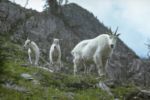 Mountain goats (Oreamnos americanus), Glacier National Park, Montana,
August 1972. I ran across this nanny and her two kids along the
Garden Wall trail while hiking from Logan Pass to Swiftcurrent Pass, and
then down to Many Glacier. They let me get pretty close, as this
picture was taken with a 105mm lens. I highly recommend the garden
wall trail, even if you just hike north a few miles from Logan Pass and
then come back. 149Kb.
Mountain goats (Oreamnos americanus), Glacier National Park, Montana,
August 1972. I ran across this nanny and her two kids along the
Garden Wall trail while hiking from Logan Pass to Swiftcurrent Pass, and
then down to Many Glacier. They let me get pretty close, as this
picture was taken with a 105mm lens. I highly recommend the garden
wall trail, even if you just hike north a few miles from Logan Pass and
then come back. 149Kb.
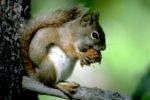 Red Squirrel (Tamiasciurus hudsonicus), Grand Tetons National Park, Wyoming, 21
June 1985. This animal is also called a chickaree locally.
This picture was taken in a small stand of conifers about 100m
across. A bend of the Snake river was on one side of the stand, and
a large open field on the other. 166Kb
Red Squirrel (Tamiasciurus hudsonicus), Grand Tetons National Park, Wyoming, 21
June 1985. This animal is also called a chickaree locally.
This picture was taken in a small stand of conifers about 100m
across. A bend of the Snake river was on one side of the stand, and
a large open field on the other. 166Kb
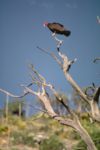 Turkey Vulture
(Cathartes aura), Guadalupe
Mountains National Park, New Mexico, 9 June 1985. 116Kb
Turkey Vulture
(Cathartes aura), Guadalupe
Mountains National Park, New Mexico, 9 June 1985. 116Kb
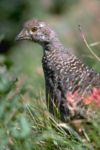 White-tailed Ptarmigan
(Lagopus leucurus), Glacier National Park, Montana,
14 August 1985. I found this female by the side of the Garden Wall
trail, just a short distance north of Logan Pass. It sat still very
obligingly as I photographed it with a 135mm lens. 152Kb
White-tailed Ptarmigan
(Lagopus leucurus), Glacier National Park, Montana,
14 August 1985. I found this female by the side of the Garden Wall
trail, just a short distance north of Logan Pass. It sat still very
obligingly as I photographed it with a 135mm lens. 152Kb
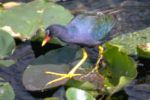 Purple Gallinule (Porphyrula martinica), Everglades National Park, Florida, April
1987. This picture was taken directly from the Anhinga trail with a
300mmm lens. The Anhinga trail is another "must see".
Especially near the end of the dry season, around March or April.
Much of the wildlife is then concentrated in a few of the deeper wet
areas. 127Kb
Purple Gallinule (Porphyrula martinica), Everglades National Park, Florida, April
1987. This picture was taken directly from the Anhinga trail with a
300mmm lens. The Anhinga trail is another "must see".
Especially near the end of the dry season, around March or April.
Much of the wildlife is then concentrated in a few of the deeper wet
areas. 127Kb
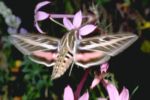 White-lined sphinx moth (Hyles
lineata), Grand Canyon National
Park (North Rim), Arizona, 10 July 1985.
White-lined sphinx moth (Hyles
lineata), Grand Canyon National
Park (North Rim), Arizona, 10 July 1985.
This moth acted just like a hummingbird. It was going from one Scarlet Gillia flower to the next sipping nectar (I presume). It was about 2 inches long and was beating its wings rapidly to hover. It looked completely black and white. I was very surprised to see the pink when I got the slides back.
This picture was actually taken in the middle of the day. The moth was beating its wings very fast, so I used a strobe at close range to freeze the action. Fortunately this was made easier by an overcast sky.
I found it impossible to follow the moth to take a picture. By the time I got set up and focused, it flew off to the next flower. After a while I noticed it was following a somewhat predictable pattern. I got several good shots by setting up on a particular blossom and waiting for the moth to come to me. 123 Kb
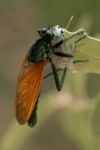 Robber Fly (Archilestris magnificus or Wyliea mydas, see text below), Tonto National Forest, Arizona, 21
July 2003. I was hiking along the ridge of Cristopher Mountain in
the northern Tonto National forest when I noticed these brightly colored
large insects often flying about knee height. I had no idea what
they were other than "cool looking bugs". I stopped to take a
picture because of the magnificent orange-red color and large size (about
2 inches long).
Robber Fly (Archilestris magnificus or Wyliea mydas, see text below), Tonto National Forest, Arizona, 21
July 2003. I was hiking along the ridge of Cristopher Mountain in
the northern Tonto National forest when I noticed these brightly colored
large insects often flying about knee height. I had no idea what
they were other than "cool looking bugs". I stopped to take a
picture because of the magnificent orange-red color and large size (about
2 inches long).
When I got back home, I looked around for what this insect might be. To my delight, I found lots of references to tarantual hawk wasps. I had heard of these and seen pictures in National Geographic specials and the like, but never figured I'd see one myself in the wild. The female tarantula hawk wasp fights an adult tarantula, stings and paralizes it, drags it back to the wasp's burrow and lays an egg on the spider. The wasp toxin only paralizes the tarantula, but doesn't kill it. When the wasp larva hatches, it feeds on the still living tarantula, leaving the vital organs for last (presumably to keep the tarantula alive and therefore fresh as long as possible). What a story!
I had always figured these wasps were rather rare. After all, there must be fewer of them than tarantulas, and you don't see those all over the place, or at least that's how I figured it.
In the process of trying to figure out exactly which species of tarantula hawk wasp I had, I came accross a web page by Professor Lenny Vincent of Fullerton College in California. His web page stated that adult tarantula hawk wasps are vegetarian, and sip nectar for a living. Hmm. My picture pretty clearly showed one of these insects munching on a moth. On the other hand, a professor of entimology isn't likely to get such facts wrong.
I sent professor Vincent my picture and referred to his statement about hawk wasps being vegitarians. The response added another interesting chapter to this tale. It turns out what I had photographed wasn't a hawk wasp at all, but a robber fly that mimics the wasp's appearance. Apparently predators have learned to stay away from the genuine article, perhaps because of its very painful sting. The flies freeload off the wasp's nasty reputation to avoid being eaten. After a few months I got a message from Professor Vincent that he had finally identified the fly as Archilestris magnifica.
It still bugs me that whatever these things were, they were rather common, at least that day at that time at that location. I had probably seen half a dozen in the previous hour, and I wasn't looking for them. But mimics are supposed to be rarer than the species they are mimicing, else the predators don't learn to avoid them. Were the others genuine hawk wasps and I just happened to photograph the mimic? Are they really that common after all? I may end up in Arizona again in July 2004 and I'm going to try my best to get to Christopher Mountain and take some good quality photographs of whatever I find up there. 208Kb
- - -
It's now June 2008 and the story continues. Last September if got a message from Roy Bekemeyer:
I believe that your Archilestris magnifica is misidentified. I have photographed and collected this species from Arizona, and determined it to be Wyliea mydas. It is a pepsid wasp mimic. In Coles' Flies of Western North America, p. 189, he describes Archilestris magnifica as having reddish brown thorax and abdomen and 40 mm long. The black-bodied and orange winged W. mydas is about 25 mm long.
He sent references to some other information that seemed to support his claim. On the other hand, the first identification came from a professor of entimology, so it has a lot of credibility too. Since I'm no expert in this, I am passing on both identifications.I have meanwhile been to Arizona every summer since 2003 and will be there again this July. I have twice gone back to Christopher Mountain, but other than getting seriously gushed on and close to getting zapped by lightening, I have no new pictures to show for it. I did notice some of the true wasps (very narrow "waist" unlike more "straight" abdomen of the flies) where the trail crosses a creek north of the mountain not far from the paved road.
The end of the Horton Springs Trail (trailhead a few miles west of the Chritopher Mountain trailhead) is the best place for seeing the wasps that I have found. I have been there three times, and each time I have found a large red or orange winged wasp. One was dragging a paralized caterpillar into a hole. The catapillar was larger than the wasp, and the wasp was having a hard time of it. This looked like a different wasp than the ones I had seen on Christopher Mountain in 2003.
If you take a left at the end of the Horton Springs trail to follow the high line trail west, you quickly cross a higher and drier area than the spring. There I saw many large insects that could barely fly coming up from the grass as I passed by. At first I thought these were some kind of beatle, but on closer inspection they were also large lumbering wasps with orange wings and very large and roundish abdoments. This must be yet another species of hawk wasps. Unfortunately none of them would sit still for me to photograph them.
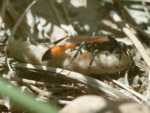 Pepsid wasp, Tonto National
Forest, Arizona, 25 July 2005. This is one of the genuine hawk
wasps as apposed to the robber fly mimic above. I hiked up the
Horton Spring trail partly to look for hawk wasps at the spring, and
wasn't dissappointed. This is a fairly easy hike to the base of the
Mogollon Rim from the campground near the beginning of the road that ends
at the Tonto Creek Fish Hatchery.
Pepsid wasp, Tonto National
Forest, Arizona, 25 July 2005. This is one of the genuine hawk
wasps as apposed to the robber fly mimic above. I hiked up the
Horton Spring trail partly to look for hawk wasps at the spring, and
wasn't dissappointed. This is a fairly easy hike to the base of the
Mogollon Rim from the campground near the beginning of the road that ends
at the Tonto Creek Fish Hatchery.
This wasp seemed to be trying to drag a catepillar several times its weight into a small hole in the ground to the top left of the picture. It would struggle and pull for a minute and move the catepillar a 1/2 inch or so. Then it would fly off for a few minutes and come back for another tugging session. I watched it perform this routine several times, but didn't wait for the catepillar to get all the way to the burrow.
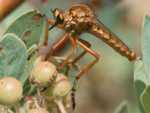 Robber Fly (Diogmites ??), Tonto National Forest, Arizona, 25
July 2005. After bumping around Horton Spring for maybe a hour where
the previous picture was taken, I hiked west along the Highline
Trail. The trail quickly crosses dryer terrain where these
manzanita bushes where growing. This robber fly caught my eye
because I was impressed how much its color matched that of the manzanita
bark. It let me get reasonably close to take a few pictures before
flying off.
Robber Fly (Diogmites ??), Tonto National Forest, Arizona, 25
July 2005. After bumping around Horton Spring for maybe a hour where
the previous picture was taken, I hiked west along the Highline
Trail. The trail quickly crosses dryer terrain where these
manzanita bushes where growing. This robber fly caught my eye
because I was impressed how much its color matched that of the manzanita
bark. It let me get reasonably close to take a few pictures before
flying off.
Scenics
-
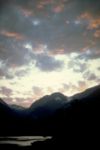 Sunset, Horseshoe Park,
Rocky Mountain National Park,
Colorado, 15 June 1985.
73Kb
Sunset, Horseshoe Park,
Rocky Mountain National Park,
Colorado, 15 June 1985.
73Kb
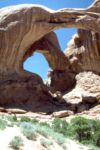 Double Arch, Arches National Park,
Utah, 27 June 1985. 214Kb
Double Arch, Arches National Park,
Utah, 27 June 1985. 214Kb
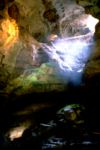 Carlsbad Cavern, Carlsbad Caverns National Park,
New Mexico, 8 June 1985.
This picture was taken shortly after entering Carlsbad Cavern thru the
natural entrance. Daylight is coming in from the entrance, which is in the
top right corner. Other areas are lit by the artificial lights mounted in
various places. While it was really neat to be there, the surreal effect
was amplified by the film.
138 Kb
Carlsbad Cavern, Carlsbad Caverns National Park,
New Mexico, 8 June 1985.
This picture was taken shortly after entering Carlsbad Cavern thru the
natural entrance. Daylight is coming in from the entrance, which is in the
top right corner. Other areas are lit by the artificial lights mounted in
various places. While it was really neat to be there, the surreal effect
was amplified by the film.
138 Kb
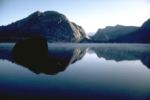 Tenaya Lake, Yosemite National Park,
California, 30 June 1985.
I took this picture practically from the front of the tent, which was in the
walk-in campground along the southwest shore of the Lake. It was a few minutes
after sunrise, with a thin mist layer on the lake. I was just about to take another
picture when the guy in the next tent site jumped into the water. So much for
the smooth glassy surface. The mist dissappeared within 15 minutes.
92 Kb
Tenaya Lake, Yosemite National Park,
California, 30 June 1985.
I took this picture practically from the front of the tent, which was in the
walk-in campground along the southwest shore of the Lake. It was a few minutes
after sunrise, with a thin mist layer on the lake. I was just about to take another
picture when the guy in the next tent site jumped into the water. So much for
the smooth glassy surface. The mist dissappeared within 15 minutes.
92 Kb
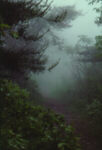 Shenendoah National Park,
Virginia, 29 May 1985.
I got up one morning at sunrise and found a thick fog. It was like walking around
in a different world. Everything was very still, and you could hear animal
activity all around but could only see a few meters. I took this picture on
one of the paths adjacent to the campground. About an hour later the fog
was mostly gone, and so was the magical feeling.
78 Kb.
Shenendoah National Park,
Virginia, 29 May 1985.
I got up one morning at sunrise and found a thick fog. It was like walking around
in a different world. Everything was very still, and you could hear animal
activity all around but could only see a few meters. I took this picture on
one of the paths adjacent to the campground. About an hour later the fog
was mostly gone, and so was the magical feeling.
78 Kb.
About the Photographer
My main expertise is in small resource-limited embedded systems, but I also have experience with computer graphics (including 3 patents), networking products, do Windows NT device drivers, helped an oil company extract information from geophysical data, and created software for handling email. See my resume if you want all the gory details. Do you need a small gizmo designed?
If you're interested in computer graphics, check out my book The Way Computer Graphics Works, published by John Wiley and Sons
And above all, thanks for stopping by.
Olin Lathrop
Embed Inc
410 Great Road
Littleton, Massachusetts 01460
United States of America
(978) 742-9014
olin@embedinc.com
Note: The email addresses olin_pc@embedinc.com and olin_apollo@embedinc.com were for internal use only, and now have been removed altogether. Please remove these old addresses from your contact list and do not use them.